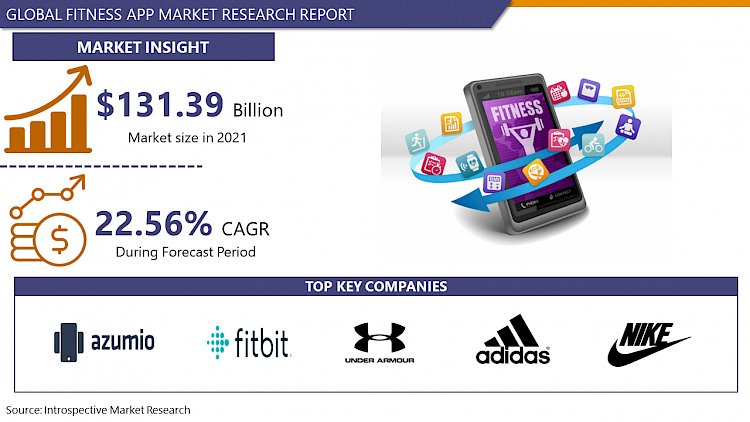
Market Overview:
The Fitness App Market was valued at USD 131.39 billion in 2022 and is predicted to grow at a CAGR of 22.56 % to USD 445.30 billion by 2028.
Apps are small, specialized programs that may be downloaded onto a mobile device like a smartphone or tablet PC. Fitness applications are created to help with exercise, other forms of physical training, nutrition and diet, and other fitness-related topics. Fitness apps, which are part of a larger collection of applications known as health apps, are part of a healthcare movement known as mobile health because they can be used at home and on the go (mHealth).
A fitness app's objective is to provide directions and examples for one or more types of exercise, physical activity, dietary regimens, or other fitness topics to the user. There are numerous fitness applications available for download on the internet. Some are designed to track workout statistics, while others are meant to collect data on walks, runs, and bike rides. Some fitness applications connect users to a personal trainer or nutritionist for assistance with specific fitness routines or workouts in general. Furthermore, when conducting workouts like running and fitness classes, certain fitness applications deliver a coordinated series of tunes, each with the same tempo.
In 2020, revenue surged by 84 percent, owing to increasing usage during the lockdown and new subscription models being tested by various apps. In terms of IAP revenue, MyFitnessPal leads the pack in both 2020 and 2021, with Strava coming in second in both years. The United States accounts for around half of IAP earnings in the fitness section. Before the epidemic, the fitness app market was almost stagnant. In 2020, it had a 45 percent increase in users, and interest has remained high in 2021, with total sessions being unchanged from 2020.
Market Dynamics and Factors:
Greater emphasis on leading a healthy lifestyle, as well as increased use of smartphones, tablets, and wearable devices, all contribute to the fitness app market's rise. Furthermore, rising awareness of diet-related ailments is boosting the fitness app market share around the world. However, technological challenges with apps, the high cost of in-app purchases, data security concerns, and rigorous laws are limiting the fitness app market's growth. During the forecast period, however, technical breakthroughs in AI and machine learning, as well as increased illness incidence of hypertension, obesity, and cardiac disorders, are projected to provide lucrative prospects for the fitness app market to grow.
Fitness App Market Report Highlight:
- • The market is divided into three segments based on deployment: iOS, Windows Fitness App, and Android. In 2026, the Android sector had the largest market share of 45.32 percent, with a market value of USD 159.17 billion for fitness apps. In 2026, the IOS segment had a market share of 39.65 percent, with a market value of USD 139.26 billion.
- • The fitness app market is divided into two types: workout apps and nutrition apps. With a market share of 76.64 percent, the Workout App segment is expected to reach a market size of USD 268.86 billion in 2026, with a CAGR of 22.62 percent. Consumer demand for the category has increased as a result of countries suffering lockdown and significant social media influence.
- North America dominated the fitness app market and is predicted to develop at the fastest rate throughout the forecast period, owing to a surge in demand for upgrading fitness systems across the region. Furthermore, the market is expected to rise because of an increase in demand from healthcare institutions for easy and risk-free fitness transformations. However, due to an increase in the requirement to monitor a rising variety of healthcare and fitness conditions such as obesity, the Asia-Pacific fitness app industry is predicted to rise significantly throughout the forecast period.
Major Key Players for Fitness App Market:
- My Diet Coach
- Nike
- Noom
- Polar Electro
- Runtastic
- Samsung Electronics
- Sports Tracking Technologies
- Wahoo Fitness
- Azumio
- FitBit
- Jawbone
- FitnessKeeper
- Under Armour
- Adidas
- Daily Workouts Apps
- Fooducate
Key Industry Development:
HealthifyMe, a health and nutrition app, will launch HealthifyMe Studio in June 2020 to offer live and interactive exercises.
Andorfins, a new product created by Andi Dorfman in January 2021, includes advanced features such as fitness challenges, goals, and workout routines.
Fitness App Market Segmentation:
By Type,
- Android
- iOS
- Other
By Application
- Health Monitoring
- Lifestyle Monitoring
- Other
For this report, Introspective Market Research has segmented the Fitness App Market based on region:
Regional Outlook (Revenue in USD Million; Volume in Units, 2022-2028)
- North America
- The U.S.
- Canada
- Mexico
- Europe
- Germany
- France
- UK
- Italy
- Turkey
- Rest of Europe
- Asia Pacific
- China
- India
- Japan
- South Korea
- Indonesia
- Vietnam
- Thailand
- Rest of Asia-Pacific
- Middle East & Africa
- Saudi Arabia
- South Africa
- Iran
- Rest of MEA
- Latin America
- Brazil
- Argentina
- Rest of LATAM






